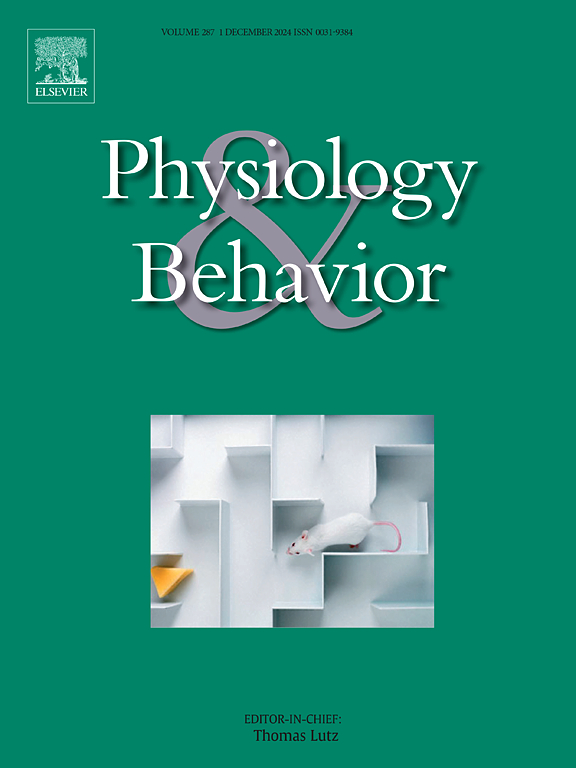Chemogenetic suppression of NST GABA neurons reveals inhibition of behavioral responses to sucrose and quinine
IF 2.4
3区 医学
Q2 BEHAVIORAL SCIENCES
引用次数: 0
Abstract
Central taste processing begins in the rostral nucleus of the solitary tract (rNST), a region rich in GABAergic neurons. We recently showed that chemogenetic activation of rNST GABA/GAD65 neurons dampens behavioral acceptance of palatable (sucrose and maltodextrin) and increases acceptance of unpalatable (quinine) taste stimuli (Travers et al., 2022). Here, we investigated whether suppressing activity in rNST GABA neurons likewise affects behavioral taste responsivity. Using mice in which Cre was expressed under the control of the GAD65 promoter, we made bilateral rNST injections of a Cre-dependent AAV driving expression of the inhibitory DREADD, hM4Di. Subsequently, we assessed concentration-dependent licking responses to sucrose, quinine, and quinine mixed in 300 mM sucrose. Relative to intraperitoneal injections of saline, clozapine-N-oxide injections significantly increased licking to sucrose and decreased licking to quinine, regardless of whether it was presented alone or mixed in sucrose. Neither oromotor (inter-lick intervals) nor appetitive (number of trials) variables were affected. Consistent with these behavioral effects, the neuronal activity marker, Fos, was expressed in more NST, reticular formation, and parabrachial nucleus cells following clozapine-N-oxide injections. A final experiment compared effects of chemogenetic GABA inhibition on sucrose licking in food deprived versus fed mice. Inhibiting GABA neurons enhanced sucrose licking in both homeostatic states. However, the impact was more marked under the latter state in female mice, suggesting a sex difference in the impact of satiety signals on GABA rNST neurons.
NST - GABA神经元的化学发生抑制揭示了对蔗糖和奎宁的行为反应的抑制。
中枢味觉加工始于孤束喙核(rNST),该区域富含 GABA 能神经元。我们最近的研究表明,rNST GABA/GAD65 神经元的化学激活会抑制对适口(蔗糖和麦芽糊精)味觉刺激的行为接受,并增加对不适口(奎宁)味觉刺激的接受(Travers 等人,2022 年)。在此,我们研究了抑制 rNST GABA 神经元的活性是否同样会影响行为味觉反应性。利用在 GAD65 启动子控制下表达 Cre 的小鼠,我们在 rNST 双侧注射了驱动抑制性 DREADD(hM4Di)表达的 Cre 依赖性 AAV。随后,我们评估了蔗糖、奎宁和奎宁与 300 mM 蔗糖混合后的浓度依赖性舔舐反应。与腹腔注射生理盐水相比,注射氯氮平-氧化物会显著增加对蔗糖的舔舐,而减少对奎宁的舔舐,无论奎宁是单独还是混合在蔗糖中。舔食运动(舔食间隔)和食欲(试验次数)变量均不受影响。与这些行为效应相一致的是,注射氯氮平-氧化物后,神经元活动标记物 Fos 在更多的 NST、网状结构和脐旁核细胞中表达。最后一项实验比较了化学GABA抑制对缺食小鼠和喂食小鼠舔蔗糖的影响。在两种平衡状态下,抑制 GABA 神经元都会促进蔗糖舔食。然而,雌性小鼠在后一种状态下受到的影响更为明显,这表明饱腹感信号对 GABA rNST 神经元的影响存在性别差异。
本文章由计算机程序翻译,如有差异,请以英文原文为准。
求助全文
约1分钟内获得全文
求助全文
来源期刊

Physiology & Behavior
医学-行为科学
CiteScore
5.70
自引率
3.40%
发文量
274
审稿时长
47 days
期刊介绍:
Physiology & Behavior is aimed at the causal physiological mechanisms of behavior and its modulation by environmental factors. The journal invites original reports in the broad area of behavioral and cognitive neuroscience, in which at least one variable is physiological and the primary emphasis and theoretical context are behavioral. The range of subjects includes behavioral neuroendocrinology, psychoneuroimmunology, learning and memory, ingestion, social behavior, and studies related to the mechanisms of psychopathology. Contemporary reviews and theoretical articles are welcomed and the Editors invite such proposals from interested authors.
 求助内容:
求助内容: 应助结果提醒方式:
应助结果提醒方式:


